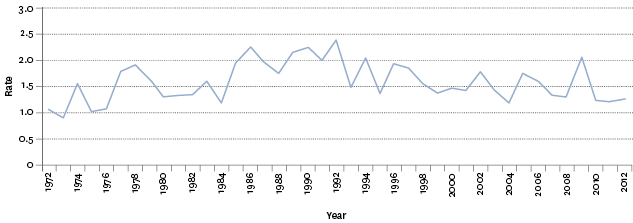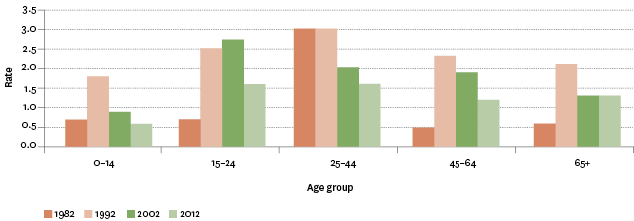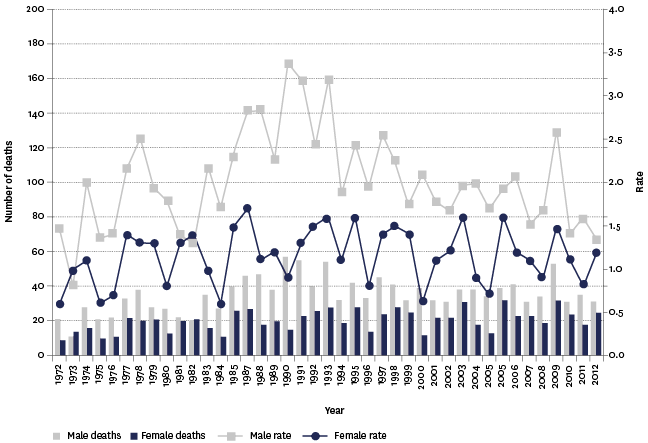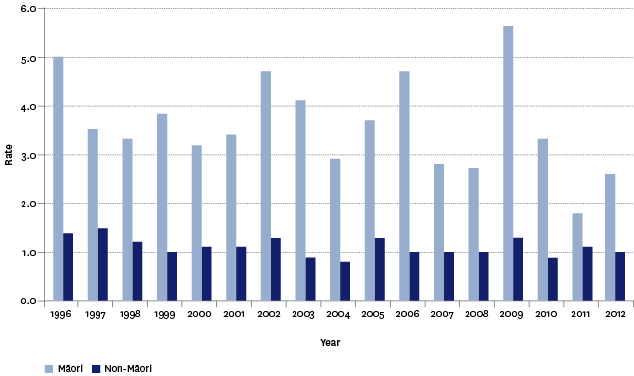Safety
Assault mortality
Definition
The number of people who have died as the result of an assault per 100,000 population.
RelevanceTop
Current level and trendsTop
From 2003 to 2012, 594 people died from an assault. This was a similar figure to the 590 people who died from an assault from 1993 to 2002, but was considerably fewer than the 649 people who died from an assault during 1983–1992.
The age-standardised assault mortality rate for the year 2012 was 1.3 deaths per 100,000, down from 1.8 per 100,000 in 2002 and 2.4 per 100,000 in 1992. The 2012 figure was, however, comparable with 1982, when there were also 1.3 assault deaths per 100,000 population.
It should be noted that rates based on small numbers can be volatile, and trends can be difficult to determine over the short term.
Figure SS3.1 – Age-standardised assault mortality rates, 1972–2012

Source: Ministry of Health
Note: Rates per 100,000 population, age-standardised to the WHO World Standard population.
Age and sex differencesTop
In 2012, the 25–44 year age group had a similar assault mortality rate to the 15–24 year age group (1.6 deaths per 100,000 population).
Of all the age groups in 2012, the 0–14 year age group had the lowest rate of deaths from assault per 100,000 population (0.6). However, those under 5 years had an assault death rate of 1.6 per 100,000 population. This is lower than the 2002 rate (1.8 per 100,000), the 1992 rate (2.8) and the 1982 rate (2.0).
Figure SS3.2 – Age-specific assault mortality rates, by age group, 1982–2012

Source: Ministry of Health
Note: Rates per 100,000 population.
The rate of assault mortality for males was usually higher than that of females. In 2012, males had a slightly higher rate of assault mortality than females (1.3 per 100,000 for males; 1.2 per 100,000 for females). The male rate was also higher than the female rate in 2002 (2.0 versus 1.6) and 1992 (3.2 versus 1.6), but the female rate was slightly higher in 1982 (1.4 per 100,000 female population and 1.3 per 100,000 male population).
Figure SS3.3 – Number and age-specific rates of assault mortality, by sex, 1972–2012

Source: Ministry of Health
Note: Rates per 100,000 population, age-standardised to the WHO World Standard population
Ethnic differencesTop
Since 1996, the Māori age-standardised rate of assault mortality has been higher than that of non-Māori, but the differences have not always been large. The Māori average age-standardised rate from 1996 to 2012 was 3.6 deaths per 100,000 Māori population, while the equivalent non-Māori rate was 1.1 per 100,000 non-Māori population.
In 2012, the Māori rate of assault mortality was 2.6 deaths per 100,000 population, and the non-Māori rate was 1.0. However, the assault mortality rates for both ethnic groups in 2012 was lower than that in 2002 (the Māori rate in 2002 was 4.7 deaths per 100,000 population; the non-Māori rate was 1.3 per 100,000 population).
Figure SS3.4 – Assault mortality rates, by ethnic group, 1996–2012

Source: Ministry of Health
Note: Rates per 100,000 population, age-standardised to the WHO World Standard population.
International comparisonTop
International comparisons can be made by looking at the assault mortality rates per 100,000 population for OECD countries for 2009–2012.
New Zealand had the 10th highest rate of assault mortality (1.2). New Zealand’s rate was above the OECD median of 0.9, and was also higher than that of Australia (0.8) and the United Kingdom (0.3). Mexico had the highest assault mortality rate at 23.4, while Luxembourg had the lowest at 0.2.
Data for this section can be found at: www.socialreport.msd.govt.nz/documents/2016/ss3.xlsx

